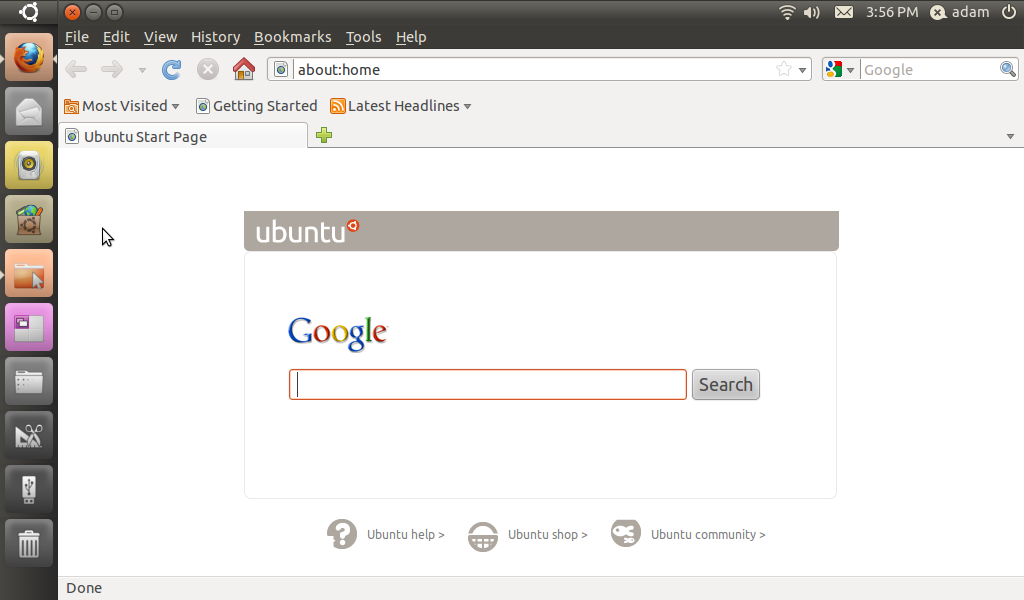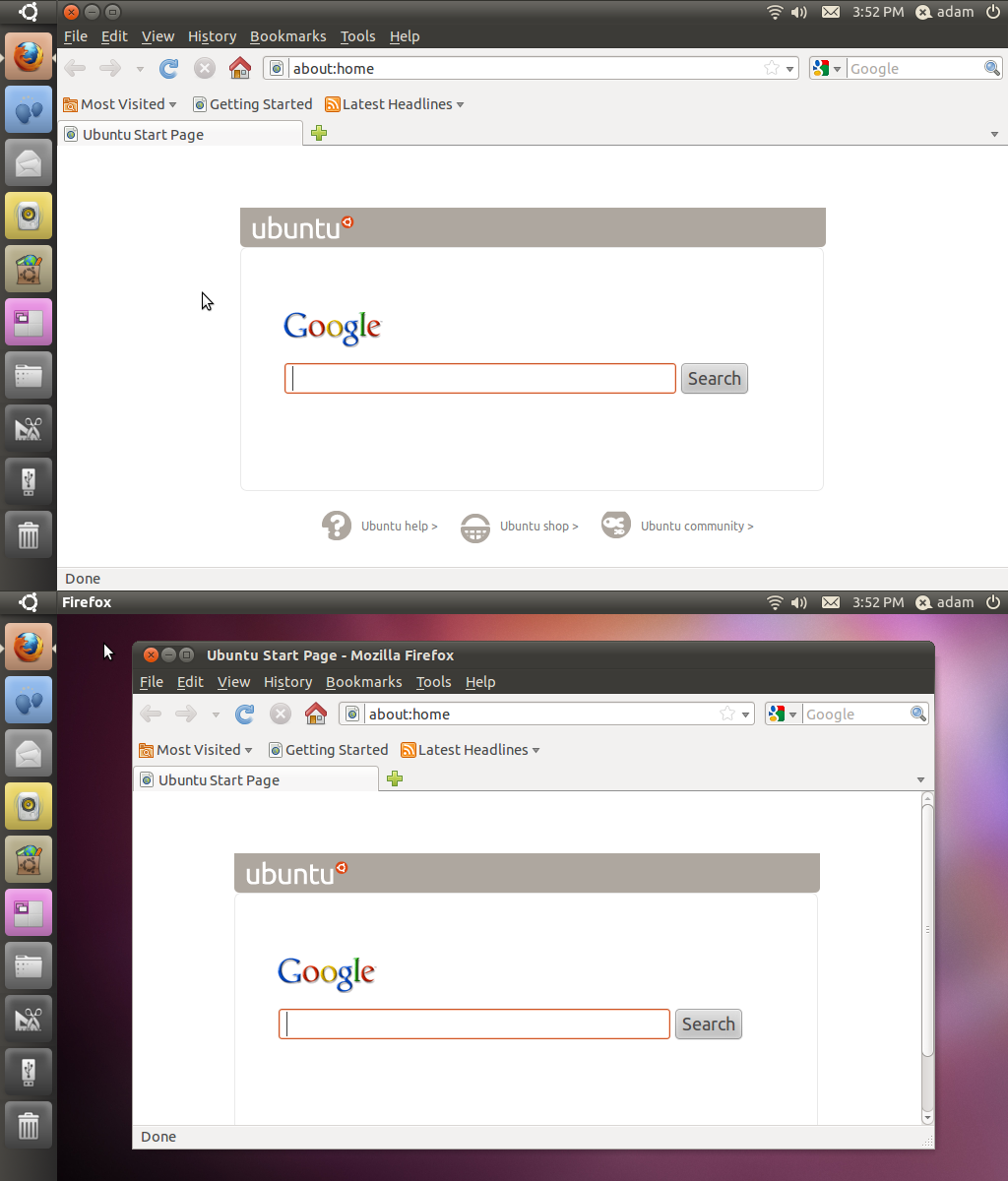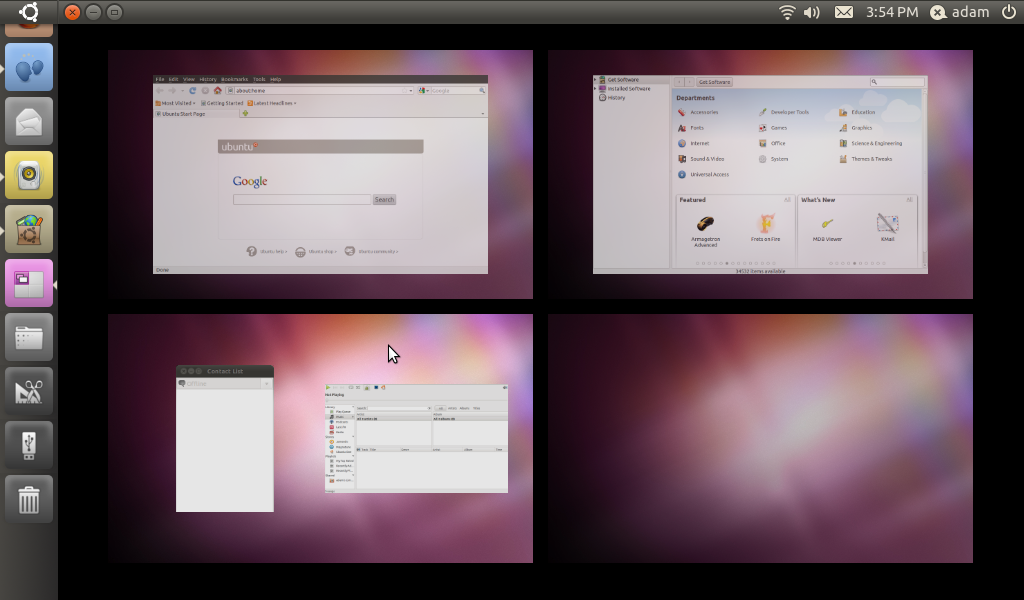Ubuntu 10.10: Maverick Meerkat Benchmarked And Reviewed
Unity
Canonical has changed the user interface of Ubuntu Netbook Edition several times since its introduction as an add-on package for Ubuntu 8.04 LTS Hardy Heron. In Ubuntu 9.04 Jaunty Jackalope, Ubuntu Netbook Remix, as it was then known, dropped most facets of the standard GNOME UI and became a stand-alone variant of Ubuntu. When the name changed from Remix to Edition in 9.10 Karmic Koala, the UI ditched some unnecessary clutter and became more streamlined. However, it remained essentially the same basic concept as earlier versions. Lucid simply refined the changes made to Karmic, and brought UNE in line with the new color scheme.
No other release has received the massive overall that went into UNE 10.10. Maverick Meerkat debuts the brand new, Canonical-developed Unity interface. Let's run down how this new user interface operates.
The Launcher
Unity removes the GNOME bottom panel and replaces it with a left-side dock, referred to as the launcher. Certain applications and tools are pinned to the launcher. UNE 10.10 comes with Mozilla Firefox 3.6.10, Empathy chat client, Evolution PIM, Cheese webcam, Rhythmbox music manager, and the Ubuntu Software Center pinned by default. Much like the Windows 7 superbar and the OS X dock, there are no word boxes to identify each application, only icons appear in the launcher. The background color of the app icons match the overall color of the icon itself, like in the Windows 7 superbar. Open unpinned applications receive an icon below pinned apps. Below applications, there is a workspace switcher, file browser, application list, and the trash can. With the exception of Workspaces, these tools appear as black and white icons. Connected devices, such as USB drives, also recieve a black and white icon in the tools area of the launcher.
A small white arrow on the left of an application's icon indicates the app is currently open. The forefront application gets a small white arrow on its right side, between the launcher and workspace. Notice in the screenshot above that the two open apps, Firefox and the file browser, have left side arrows. As the forefront app, Firefox also gets the right-side arrow.
Unity's launcher, although nothing like the dock in OS X, does have a few animations. When the launcher has too many icons to display fully, a fold animation tiles some of the icons. Applications are folded up and tiled at the top of the launcher to free up space. Likewise, tools are folded down and tiled at the bottom. Both apps and tools fold out of the way when the launcher gets really full. Unity even greets you with a 'popping' icon when opening an application from the launcher.
Pinned icons can be removed from the launcher by right-clicking them and selecting Remove from launcher from the menu that appears. Open unpinned applications can be pinned to the launcher by right-clicking on their icon and selecting Keep in launcher. Icons of pinned applications can be rearranged by dragging them off the launcher. A white line will appear showing the new position. Releasing the mouse re-pins the icon in its new position.
Get Tom's Hardware's best news and in-depth reviews, straight to your inbox.
Top Panel
The top panel remains mostly unchanged from Ubuntu Desktop Edition. The user/logout applet, which controls current user status and logout/shutdown functions, still resides on the far-right end of the panel. Going from right to left, the clock/calendar applet is next, though the default view has been shortened to only show the time. The indicator applet for things like mail/message notification, network status, Bluetooth, and volume are last on the right side.
The majority of the center portion of the panel is reserved for the current application, explained in the next section. In the far-left end of the panel, an Ubuntu button, which activates the home screen, takes the place of the Applications/Places/System menu; more on this later.
Window Behavior
Applications are meant to be maximized in Unity. The top panel absorbs the window buttons and file menu of maximized apps, although it is still possible to restore many maximized apps to their windowed form, and occasionally an application will open this way. When windowed, the window buttons return to the top-left of an applications title bar. However, the file menu remains in the upper panel, just like in Macintosh operating systems.
Home Screen
Unity employs a home screen like previous versions of UNE and many other netbook-optimized user interfaces. Unlike previous versions of UNE, the home screen doesn't always cover the wallpaper in lieu of a desktop. Clicking the Ubuntu logo in the top-left corner of the UI brings up the home screen. This screen contains a search tool at the top and extra-large links to apps for Web, Music, Photos & Videos, Games, Email & Chat, Office, Files & Folders, and Get New Apps. For Windows users: think of the Ubuntu button as the Start button. And think of the home screen as a start menu, which takes up the entire screen.
Workspaces
Unity does not have a traditional desktop like Ubuntu Desktop Edition, Windows 7, or OS X. When the home screen is not activated and no apps are in the forefront, a wallpaper exists, but there is no actual usable desktop. No icons, shortcuts, or files can appear on this desktop. That's because Unity employs the workspace model instead. Workspaces simply function as space for windows to fill, but nothing else that a regular desktop does.
Though Unity eschews the desktop model, it does allow for multiple desktops--or in this case workspaces. This is essentially the same as virtual desktops in Ubuntu Desktop Edition without the interactive desktop, and an emphasis on maximized applications. The user can organize open applications by arranging them in different workspaces. Unity has four workspaces to divide applications into. Moving apps from one workspace to another is just a matter of drag and drop. Simply open the Workspaces tool in the launcher to bring up the Workspaces screen.
Reach Out And Touch
One of Unity's new features is a multitouch language, presumably called “uTouch.” This is the first time Canonical has added multitouch support in a release, and Unity was designed with this input paradigm in mind. We don't have a multitouch monitor or tablet on hand to test the uTouch functionality of UNE 10.10. But we look forward to getting hands-on with Unity whenever a suitable piece of hardware is available. Below is a video of Gerry Carr, head of platform marketing at Canonical, demoing Unity on a multitouch device.
One of the many foci for Ubuntu 11.04 (Natty Narwhal) is going to be uTouch improvements. With slates being the next big thing in mobile computing, we'll be keeping a close eye on how Canonical intends to make Ubuntu alive and competitive on this new form factor.
-
"With the appearance of Windows 7 on slate devices in perpetual limbo"Reply
http://www.dailytech.com/HP+Slate+Powered+by+Windows+7+Launches+at+799+is+Business+up+Front/article19953.htm
http://h10010.www1.hp.com/wwpc/us/en/sm/WF06a/321957-321957-64295-3841267-3955550-4332585.html
How is that Limbo? You can buy one right now. -
adamovera I didn't know they were taking pre-orders yet, though HP Slate doesn't ship until the middle of November. Unfortunately, the HP Slate looks like a really half-hearted attempt. Business product? That pretty much means not to get your hopes up. It should have been out much closer to the iPad, but got pushed back repeatedly. Ever since they bought Palm it seems like their Windows efforts in this form factor will take a backseat until they try to make WebOS work - can't blame them really, WebOS is pretty slick and they paid a lot for it. But I still do want to get my hands on the Slate, but look forward to seeing what they do with WebOS more now.Reply -
arkadi If we "put all the issues aside", i love allot of things.....Don't get me wrong, i love to play with Linux at home, but at the moment I prefer to use it at work, in the server room ware it belongs (at the moment). Using it at home it just to much of an effort, to many issues, hardware compatibility etc...Hopefully one day...Reply
Any way Ubuntu came a long way to make it happen....But still few days ago i tried it and few others on a net book, with via chip set and CPU with no luck... -
TomSah "Ubuntu 10.10 Netbook Edition is also a mess. As a netbook operating system intended for actual people to use in a production environment, I have to say that UNE 10.10 should be avoided. From our experience on the Dell Mini 10v, UNE Meerkat is in no way ready for general consumption. Its many bugs and poor performance are just not acceptable or at all realistic for the average end-user. Loading almost anything on UNE 10.10 was clearly sluggish"Reply
Wow. Im running 32-bit Maverick UNE on my Asus eee 1000HA and i have to say that i fell in love as soon as it installed! As soon as i disabled the unity interface to get the desktop interface I was away laughing! I havnt had any of the problems you mention, app startup has been great, no crashes/bugs - And this is my first serious attempt at using a Linux distro. I had a lot of fun tweaking everything to my liking and i now feel like I have the perfect OS for me. Its really strange you had bad experiences like that, must be the dell mini haha. -
adamovera TomSah:Reply
As soon as i disabled the unity interface to get the desktop interface I was away laughing!
Well there you go, you got rid of Unity. I don't doubt it works fine now, LOL. I'm using the 10v with 10.10 32-bit Desktop Edition right now and it's absolutely fantastic, one of the best OSes on this thing by far. The track pad is a nightmare, and there's no fixing that, but in 10.10 it's much better than earlier versions. Tap to click is the best in Windows 7, but drag and drop in Ubuntu is much less maddening than Win7. -
randomizer Just moving the cursor up and down the launcher shows how slow Unity is. The delay between when the cursor moves over an application to when the application's name pops up gives the impression of playing a game at very low framerates.Reply
The Ubuntu font looks ok but it's really only usable in menus and window titles (which I think is all it is used for, fortunately). There's no way such a stylised font could be readable for long periods in a document.
Adam, you should see if any updates fixed the consistently inconsistent HDD to HDD file copy performance.
9503393 said:How come you don't compare the benchmarks to Windows?
Because Windows is not a Linux distro, and this review is for a Linux distro? -
adamovera randomizer:Reply
Adam, you should see if any updates fixed the consistently inconsistent HDD to HDD file copy performance.
As of 10/22/10, when I re-tested the HDD to USB times, they had not.
pinkfloydminnesotaHow come you don't compare the benchmarks to Windows?Workin' on it, stayed tuned. But randomizer is right, this is a review of the new Ubuntu release. As a review of the new version of a software product, this type of article isn't the appropriate forum for that comparison. -
64 bit vs. 32 bit? 32 seems much better all round, stability, compatibility etc.. Is there that much speed difference to be worth using 64 bit?Reply
gvnmcknz








